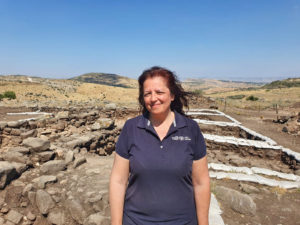Excavators uncover abandoned farmstead from the Hasmonean Era
Nathan Steinmeyer May 30, 2022 0 Comments 799 views


The ancient farmstead uncovered in the Galilee. Courtesy Assaf Peretz, Israel Antiquities Authority.
In an exciting discovery, excavators from the Israel Antiquities Authority (IAA) came across an ancient farmstead frozen in time, its remains left largely untouched for more than two millennia. The farmstead, which dates to the second half of the second century B.C.E., was uncovered during a salvage excavation in the eastern Galilee. The farm was discovered in pristine condition, with only some of its stones missing or removed. The most interesting part, however, is that nearly all of the farm’s tools and equipment were found exactly as the inhabitants had left them when they were forced to flee suddenly, never to return. But who were the site’s inhabitants?


According to excavation director Amani Abu-Hamid, “We were very lucky to discover a time-capsule, frozen in time, in which the finds remained where they were left by the occupants of the site, and it seems that they left in haste in face of an impending danger, possibly the threat of a military attack.” The dating of the farmstead corresponds to the expansion of the Judean Hasmonean dynasty into the Galilee region. “It is possible that the farmstead was abandoned in the wake of these events,” said Abu-Hamid. However, it is still too soon to draw definitive conclusions regarding the identity of the inhabitants or any connections they may have had to the Seleucid authorities who held sway over Galilee at the time.
[embedded content]
The excavations of the site, near Nahal Abel, discovered several loom weights used for weaving, large ceramic storage vessels, and iron agricultural implements, including various picks and scythes. “The weaving loom weights were still on the shelf, the storage jars were intact,” said Abu-Hamid. The condition of the finds provides a lot of information about daily life in the Galilee during this period, which is not well represented in the archaeological record. According to Abu-Hamid, in an interview with The Times of Israel, “It is a very important and valuable site to teach us about the spread of the Hasmonean Empire.” Given the large number of loom weights, the team suggests that the farmers likely kept sheep and used their wool in the production of textiles.
The team also uncovered several coins that they used to date the site. Carbon-14 samples were also taken and are now being analyzed. Beyond the second century remains, the IAA also uncovered building foundations, pottery, and other finds dated to the tenth through ninth centuries B.C.E. This Iron Age site also appears to have been a small agricultural outpost.


Amani Abu-Hamid of the Israel Antiquities Authority. Courtesy Miri Bar, Israel Antiquities Authority
Read more in Bible History Daily:
All-Access members, read more in the BAS Library:
The Hasmonean Kings: Jewish or Hellenistic?
The Galilee Boat—2,000-Year-Old Hull Recovered Intact
Not a BAS Library or All-Access Member yet? Join today.


